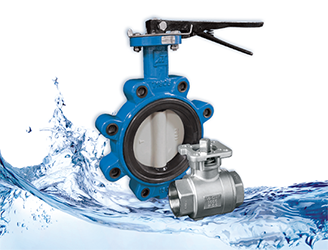
Considerations for matching valves to water service applications
Mike Edwards
Features A-T Controls potable water standards
Before a ball or butterfly valves is chosen for a particular water service application, it helps to understand what types of water might be encountered.
Common types of water are deionized, demineralized, distilled, and potable. Deionized water is water that has most of its mineralized ions removed. Demineralized water has its mineral impurities removed. Distilled water is purified through distillation, a process that exploits the volatility of liquids using evaporation and condensation to separate components.
In the case of potable water, impurities in the water that have higher boiling points than water are removed. Potable water is commonly known as drinking water. Potable water has been filtered and purified to meet local standards and is generally free from harmful bacteria.
NSF/ANSI 61 and 372
NSF/ANSI has two standards, NSF 61 and NSF 372, which define requirements for the water quality and lead content for potable water equipment. NSF/ANSI 61 is a standard which ensures that the product meets the requirements to manufacture, sell or distribute water in North America.
To make the products safe for water distribution there must be protective barrier material, joining, and sealing materials. These materials will ensure that the water remains free from any contaminates that may be present on or in the metal, paint, gaskets, lubricants, etc. NSF/ANSI 372 is the standard which established the set procedure for limiting the amount of lead in water
Water Purification
Deionized, demineralized and distilled water are very similar types of purified water, however the process in which each is purified is different. Deionization and demineralization remove the contaminates from the water, but distillation will remove the water from the contaminates.
Deionization and demineralization are purified through ion exchange (IX). IX is the separation of ions from water which is done using an insoluble solid (IX resin) and the water solution. For the removal of cations (positively charged ions), Sodium is typically founded on the resin surface and for anions (negatively charged ions) chloride is used. The positively charged unwanted cations are exchanged with the positively charged ions on the resin surface and negatively charged unwanted anions are exchanged with the negatively charged ions on the resin surface.
Distilled water is purified through distillation, a separation process in which a liquid is heated to boiling. Its vapours then rise in the distillation column and enter a condenser. The condenser has cold water flowing on the outside of the distillation column with the heated vapour inside and allows the vapour to condense into the liquid phase. Purified water will then be running out of the condenser, leaving the contaminates at the heat source.
Valve Cleaning and Lubrication Considerations
The NS ball valve and butterfly valve series from A-T Controls are free from lubrication.
Deionized, distilled, and demineralized water can react and cause leaching from materials of construction. Filled PTFE is not recommended because of this in these applications. Standard valve assemblies/materials of construction can be used on water service if NSF/ANSI 61 and NSF/ANSI 372 is not specified or required.
Standard Material
To determine the material of construction and preparation of the valves for service being compatible with any water application, consult with A-T Controls, the contributor of this article.
Print this page